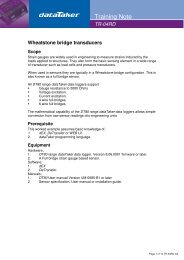You also want an ePaper? Increase the reach of your titles
YUMPU automatically turns print PDFs into web optimized ePapers that Google loves.
Using <strong>CANgate</strong><br />
Memory Slots<br />
By default, <strong>CANgate</strong> will not send or receive any CAN messages. In order to do anything useful, it must first be programmed.<br />
<strong>CANgate</strong> is programmed by sending commands to set up one or more memory slots. Each memory slot can be configured<br />
to perform one of the following functions:<br />
Slot type Class Action<br />
RECV<br />
RECVE<br />
passive receive CAN messages with a specified identifier value, extract the specified data field and return<br />
its value as a formatted ASCII value<br />
RECVJ passive receive CAN messages relating to a specified J1939 PGN number, extract and return the<br />
specified data field<br />
GPS passive receive NMEA-0183 messages of the specified sentence type, extract and return the specified<br />
data field<br />
SEND active send a CAN message<br />
SENDE<br />
RQST active request an ISO-14230 parameter, wait for the reply, extract and return the specified data field<br />
RQSTJ active request a J1939 PGN, wait for the reply, extract and return the specified data field<br />
As can be seen, there are two classes of slots: passive and active.<br />
For RECV, RECVE, RECVJ and GPS slots, <strong>CANgate</strong> passively receives all matching messages then returns the last known<br />
data value either at a fixed rate, or when requested by the host (data logger or computer). Statistical calculations can<br />
optionally be performed, resulting in a min/max/average value being returned instead of an instantaneous value.<br />
For SEND, SENDE, RQST and RQSTJ slots, <strong>CANgate</strong> will take the specified action (ie. transmit a message and possibly<br />
wait for a reply) either at a fixed rate or when requested by the host.<br />
In all cases, one memory slot corresponds to one data value of interest. So if a particular type of CAN message contains six<br />
separate values packed into its data area, of which four are of interest, then you would set up four memory slots – each one<br />
configured to extract a different subfield.<br />
Up to 150 memory slots (which are referred to by number, 1-150) can be set up. Slot configurations are automatically saved<br />
to flash memory so that operation will automatically resume following a power interruption.<br />
One further memory slot, Slot 0, is provided. This is intended to be used as a "scratch pad" for one-off requests, ie. it may be<br />
reprogrammed many times during operation. This slot's configuration is not saved to flash.<br />
UM-0086-A2 <strong>CANgate</strong> User’s <strong>Manual</strong> Page 12



